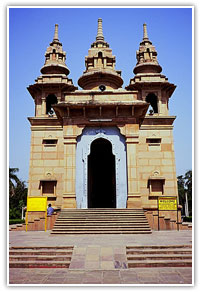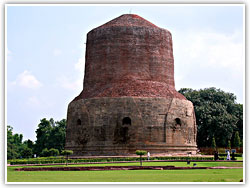|
|
Sarnath, Varanasi
.............................................................................................................................................................................. |
|
Sarnath, Varanasi
Sarnath, a world famous Buddhist site is about 10 kms. from Varanasi. Sarnath is one of Buddhist’s
major centres in India. In Sarnath, the Lord
Buddha preached his first sermon at a deer park.
The sermon is known as Dharmachakkapavattana or
Dharmachakra or setting in motion the Wheel of Law
in Buddhism. Sarnath became one of the great
centres of Buddhism. The Emperor Ashoka erected
magnificent stupas and structures in Sarnath. The
Chinese scholar Huien Tsang who also visited
Sarnath in 640 AD, wrote about the splendour of
the city. This place was rediscovered and
excavated in 1836. Sarnath is one of the most holy
sites that attracts the people from all over the
world. The people visit this place to pay homage
to the great teacher and to attain spiritual
perfection.
History of Sarnath |
 |
|
|
After attaining enlightenment at
Bodhgaya, Lord Buddha went to Sarnath. In Sarnath, the
stream of the Buddha's teaching first flowed. At this
place, the Buddha encountered the five men who had been
his companions of earlier austerities. Here in the Deer
Park, he delivered his first sermon, or in religious
language, set in motion the Wheel of Law (Maha-Dharmachakra
Pravartan) in 528 BC. Since then, the site has been
revered. The Emperor Ashoka (304 - 232 BC), who spread
the Buddha's message of love and compassion throughout
his vast empire, visited Sarnath around 234 BC, and
erected a stupa here. The last and largest monastery
constructed before the Muslim rule was Dharma-Chakar-Jina
Vihar. This Vihar was erected by Kumardevi, wife of King
Govinda Chandra, who ruled over Banaras during 1114 to
1154. In 1194 AD, Qutb-ud-din-Aibak, the Muslim
conqueror, leveled the city to the ground. Sarnath
became a forest of debris below which the historical
ruins remained buried. Several Buddhist structures were
raised at Sarnath between the 3rd century BC and the
11th century AD. Both the Chinese travelers Fa-Hien and
Hiuen Tsang visited Sarnath, the former at the beginning
of the 5th century AD, the latter in 640 AD. Hieun Tsang
described the sangharama (monastery) as having 1500
monks, a 65 m high vihara, a figure of the Buddha
represented by a wheel, a 22 m high stone stupa built by
Asoka, a larger 90 m high stupa and three lakes. The
remains here and the sculptures now housed at the Indian
Museum, Calcutta and the National Museum, Delhi reveal
that Sarnath was a centre of religious activity,
learning and artistic endeavour continuously from the
4th century BC to 9th century AD. Sarnath was probably
destroyed when Muslim armies devastated the region in
1197.
Tourist Attractions in Sarnath
The main tourist attractions in Sarnath are the Stupas,
excavated ruins of monasteries, Ashoka Pillar, Deer
Park, where the Buddha delivered his first sermon,
Dhamekh Stupa, Bodhi tree, Moolgandha Kuti Vihara and
Archaeology Museum. |
|
|
|
Dhamekh Stupa
Of the two great stupas which adorned the city,
only the Dhamekh Stupa survives, which belongs to
the 6th century. The Dhamekh Stupa is the most
imposing monument at Sarnath. This imposing stupa
was erected in 200 BC in the Mauryan era. It
consists of a 28 m diameter stone plinth which
rises to a height of 13 m. There are 8 faces, each
with an arched recess for an image. Above this
rises a 31 m high cylindrical tower. The upper
part is brick and was probably unfinished. The
|
 |
|
|
central
portion is elaborately decorated with Gupta designs like
luxuriant foliation, geometric patterns, birds and
flowers. Excavations have revealed that the stupa was
enlarged on six occasions and the well known figures of
Boddhisattva standing and the Buddha teaching were found
around the monument. Dhamekh Stupa is believed to be the
place where the master gave his first discourse to the 5
ascetics became his first disciples. This event ranks
along with his birth, enlightenment and death as one of
the 4 most significant in his existence.
Ashoka Pillar
This pillar was erected by the Emperor Ashoka. The
pillar had his edict engraved on it. This stupa is about
15.24 m in height and had four lions as its capital
which is now treasured in the archaeology museum. The
lion symbolises both Ashoka's imperial rule and the
kingship of the Buddha. The four-lion capital was
adopted as the emblem of the modern Indian republic.
Moolgandha Kuti Vihara
The Mulagandha Kuti Vihar is a modern temple erected by
the Mahabodhi Society. It has a life-size statue of the
Lord Buddha in the Dharmachakra Pravartan form. It also
has excellent frescoes by Kosetsu Nosu, Japan's foremost
painter, depicting scenes from the Buddha’s life and a
rich repository of Buddhist literature.
Bodhi Tree
The sapling of the Bodhi tree was brought from the
famous tree in Anuradhapura, Sri Lanka, which in turn
originated from the original tree at Bodhgaya, under
which the Lord Buddha attained enlightenment about 2,500
years ago. It was planted here in 1931.
Archaeology Museum
Archaeology Museum was constructed in 1910. This museum
displays the capital from the Ashoka pillar and other
relics found on the site including sculpture from the
Mauryan, Kushana, Gupta and various other periods, a
Sunga Period stone railing, Kushana Period Boddhisattvas,
Gupta Period figures, including the magnificent seated
Buddha. There is a rich collection of Buddhist
sculptures comprising numerous Buddha and Bodhisattva
images, considered amongst the finest specimens of
Buddhist art. The museum also houses Buddha figures in
various postures dating back to the 5th and 6th
centuries and images of Hindu gods such as Saraswati,
Ganesh and Vishnu from 9th to 12th centuries.
Deer Park
The Deer Park is holy to Jains because Shreyamshanatha,
the 11th Tirthankara died here. The monastery in the SW
corner is one of 4 in the Deer Park. The other 3 are
along the N edge. All of brick with cells off a central
courtyard. All are in ruins.
Dharmarajika Stupa
The Dharmarajika Stupa was built by the emperor Asoka to
contain relics of the Buddha. Like the Dhamekh Stupa
this was enlarged on several occasions but was destroyed
by Jagat Singh, the Prime Minister to the Maharaja of
Varanasi in 1794. At its core was found a green marble
asket containing human bones and pearls which Jagat
singh ordered to be thrown into the Ganga. Mr. Duncan,
British Resident at the Maharaja’s court, published an
account of the discovery thereby drawing Western
scholars attention to the site.
Main Shrine
The Main Shrine is a rectangular building 29 m by 27 m
with doubly recessed corners reaching 5.5 m in height.
It is believed that this is where Buddha settled in the
Deer Park. The building is attributed to Asoka and the
later Guptas. The concrete path and interior brick walls
were added later to reinforce the building. To the rear
is the lower portion of a polished sandstone Asokan
Column. The original was about 15 m high and was topped
by a capital which is now housed in the Archaeological
Museum. This comprises of four lions sitting back to
back with the wheel of law between them. It is now
symbol of the Indian Union. The remaining part is only 5
m high. The column was one of many erected by Asoka to
promulgate the faith and this contained a message to the
monks and nuns not to create any schisms and to spread
the word.
Chaunkandi
At Chaunkandi about 1 km to the south is the site of a
5th century Stupa. On top of this is an octagonal brick
tower built by Akbar in 1588 to commemorate the visit
his father Humayun made to the site. The inscriptions
above the doorway reads ‘As Humayun, king of the Seven
Climes, now residing in paradise, deigned to come and
sit here one day, thereby increasing the splendour of
the sun, so Akbar, his son and humble servant, resolved
to build on this spot a lofty tower reaching to the blue
sky.’
Festivals in Sarnath
Buddha Purnima is celebrated in the month of May in
Sarnath. It marks the birth of the Buddha. A huge fair
is held when his relics (which are not on public display
at any other Time) are taken out in procession. |
|
|
|